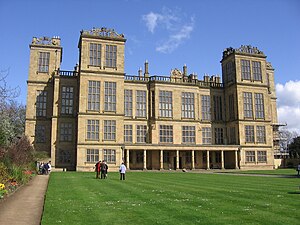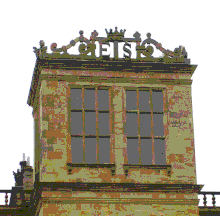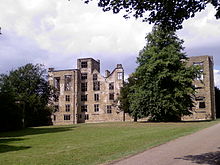Hardwick Hall



Hardwick Hall in Derbyshire, is a grand Elizabethan country house. Built between 1590–1597 for the formidable Bess of Hardwick, it was designed by the architect Robert Smythson, an exponent of the Renaissance style of architecture. Hardwick Hall is one of the earliest examples of the English interpretation of the style, which came into fashion having slowly spread from Florence. Its arrival in Britain fortuitously coincided with the period when it was no longer necessary or legal to fortify a domestic dwelling. Ownership of the house was transferred to the National Trust in 1959. Today, it is fully open to the public.
The house is sited on a hilltop between Chesterfield and Mansfield, overlooking the Derbyshire countryside.
History
Hardwick Hall was designed for Bess of Hardwick, Countess of Shrewsbury and ancestress of the Dukes of Devonshire, by Robert Smythson in the late 16th century and remained in the ownership of her descendants until the mid-twentieth century.
In the days of Queen Elizabeth I, Bess of Hardwick was the richest woman in England after The Queen herself, and as such her house was conceived to be a conspicuous statement of the wealth and power. The windows are exceptionally large and numerous for the period and were a powerful statement of wealth at a time when glass was a luxury, leading to the saying, "Hardwick Hall, more glass than wall." [1] The Hall's chimneys are built into the internal walls of the structure, to give more scope for huge windows without weakening the exterior walls.
The house's design also demonstrated new concepts in not only in domestic architecture, but also a more modern way in which life was led within a great house. Hardwick was one of the first English houses where the great hall was built on an axis through the centre of the house rather than at right angles to the entrance.
Each of the three main storeys has a higher ceiling height than the one below - the ceiling height being indicative of the importance of the rooms' occupants - least noble at the bottom and grandest at the top. Previously the nobility had lived in close proximity to those who served them, from this period onwards servants and masters lived apart in clearly designated areas.
A wide, winding, stone staircase leads up to the state rooms on the second floor; these rooms include one of the largest long galleries in any British house and also a little-altered, tapestry-hung great chamber with a spectacular plaster frieze illustrating hunting scenes.
Hardwick was but one of Bess's many houses. Each of her four marriages had bought her greater wealth; she had been born in the now old Hall at Hardwick, which today is a ruin besides the 'new' hall. After her death in 1608, the house passed to her son William Cavendish, 1st Earl of Devonshire. His great-grandson, William, was created 1st Duke of Devonshire in 1694. The Devonshires made another of Bess's great houses, Chatsworth, their principal seat. Hardwick thus became relegated to the role of an occasional retreat for hunting and sometime dower house. As a secondary home, it escaped the attention of modernisers and received few alterations after its completion. In fact, from the early 19th century, its antique atmosphere was consciously preserved. A low, 19th century service wing is fairly inconspicuous at the rear.
In 1950, the unexpected death of 10th Duke of Devonshire and the subsequent death duties (rated at 80%) caused the sale of many of the Devonshire assets and estates. At this time, Hardwick was occupied by the Evelyn, Duchess of Devonshire, the widow of the 9th Duke. The decision was taken to hand the house over to HM Treasury in lieu of Estate Duty in 1956.[2] The Treasury transferred the house to the National Trust in 1959. The Duchess remained in occupation of the house until her death in 1960. However, hostile to the Trust, the now elderly lady seldom visited the house in her final years.[3] Having done much to conserve the textiles in the house, she was to be its last occupant.[4]
Features
Hardwick Hall contains a large collection of embroideries, mostly dating from the late 16th century, many of which are listed in the 1601 inventory. Some of the needlework on display in the house incorporates Bess' monogram "ES", and may have been worked on by Bess herself.
There is a large amount of fine tapestry and furniture from the 16th and 17th centuries. A remarkable feature of the house is that much of the present furniture and other contents are listed in an inventory dating from 1601.
Today
Hardwick is open to the public. It has a fine garden, including herbaceous borders, a vegetable and herb garden, and an orchard.
The extensive grounds also contain Hardwick Old Hall, a slightly earlier house which was used as guest and service accommodation after the new hall was built. The Old Hall is now a ruin. It is administered by English Heritage on behalf of the National Trust and is also open to the public. Many of the Old Hall's major rooms were decorated with ambitious schemes of plasterwork, notably above the fireplaces. Remarkably, impressive fragments of these are still to be seen (protected by preservative coatings and rain-shields), though most of the building is unroofed.
Architectural historian Dan Cruickshank selected the Hall as one of his five choices for the 2006 BBC television documentary series Britain's Best Buildings.[5]
Innovational in its own time, it would serve, three centuries later, as a source of inspiration for the enormous Main Exhibition Building at the Philadelphia Centennial Exhibition of 1876. Hardwick Hall was an ideal model for a building which was intended to merge historicism with the large expanses of glass that had become de rigueur for the main exhibition halls at international expositions and fairs in the wake of the enormous success of The Crystal Palace constructed for the 1851 London Exhibition.[6]
Contemporary references
Hardwick Hall has appeared in a number of films and television productions, including:
- Connections (television series) to illustrate a long series of changes that occurred in home design as a result of the Little Ice Age
- Britain's Best Buidlings, television documentary, 2006
- Harry Potter and the Deathly Hallows (Parts 1 and 2); exterior scenes of Malfoy Manor
- Mastercrafts, episode 6 on stonemasonry, in which trainees vied to create fitting sundials for the garden of Hardwick Hall
Outside links
| ("Wikimedia Commons" has material about Hardwick Hall) |
- Images of England — details from listed building database (79178) Hardwick Hall
- Hardwick Hall information from the National Trust
- Hardwick Old Hall visitor information from English Heritage
- Hardwick Hall, Doe Lea Robert Smythson for Bess Hardwick, 1597 (Floor plans and plan of grounds) PDF by London Metropolitan University
References
- ↑ Another version is "more window than wall." Sir Nikolaus Pevsner writes, "The little rhyme is: 'Hardwick Hall, more window than wall.' Nikolaus Pevsner, A History of Building Types. London: Thames and Hudson, 1976, p. 324, note 80.
- ↑ Chatsworth: Home of the Duke and Duchess of Devonshire; Derbyshire Countryside Ltd; 2005: p56.
- ↑ Hardwich Hall; The National Trust; 2006; ISBN 978-1-84359-217-4: p 72
- ↑ Hardwich Hall; The National Trust; 2006; ISBN 978-1-84359-217-4: p72.
- ↑ Cruickshank, Dan. "Britain's Best Buildings". BBC Four. http://www.bbc.co.uk/bbcfour/documentaries/features/bbb-hardwick.shtml. Retrieved June 3, 2008.
- ↑ Nikolaus Pevsner, A History of Building Types. London: Thames and Hudson, 1976, p. 248.
